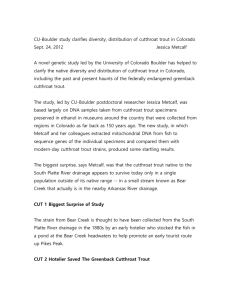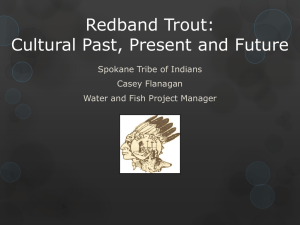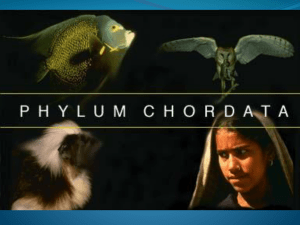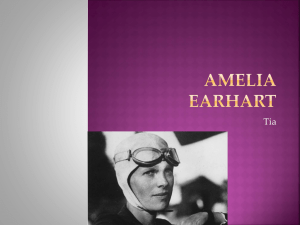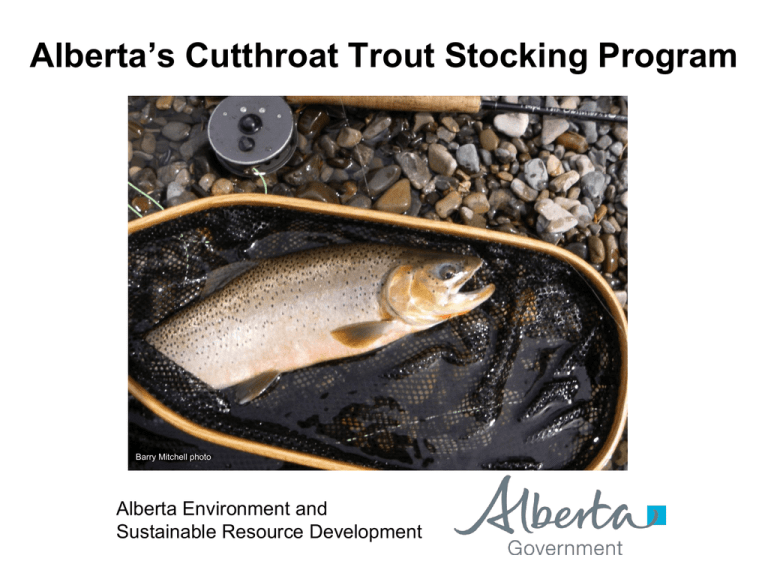
Alberta’s Cutthroat Trout Stocking Program
Barry Mitchell photo
Alberta Environment and
Sustainable Resource Development
Outline
This presentation is intended to provide a summary of
the purpose for, and activities involved in Alberta’s
Cutthroat Trout Stocking Program, including:
– Background of the species and their qualities.
– Development of a wild brood stock in and for Alberta.
– Establishment of a field camp every two years to
collect cutthroat eggs for culturing.
– The egg collection and fertilization process.
– Hatching, rearing and stocking of cutthroat trout.
– The types of fisheries that result.
– Program benefits to Albertans.
Background
• Cutthroat trout are native to the upper Bow River and
Oldman River systems in Alberta.
• They have been introduced widely into the upper Red
Deer and North Saskatchewan River systems, and to a
lesser degree in the Wapiti River system (Torrens River).
• They are very hardy, and able to
thrive in less-productive headwater
streams and high elevation lakes.
• Cutthroat trout are sought after by
anglers partly due to being easily
caught, but also for the remote and
scenic places they live.
Barry Mitchell photo
Background (cont’d)
• The genetic compatibility of stocked fish is important to
prevent tainting of native stocks.
• Many of Alberta’s high country lakes could not be stocked
if cutthroat trout were unavailable.
Alberta’s Cutthroat Brood Stock
• Cutthroat were first stocked into
streams and lakes in Alberta
during the 1950’s, creating some
very good fisheries (i.e. Ram R.
system), and a number of selfsustaining populations.
• Since then, this species has been stocked into high country
habitats, most of which were historically barren of fish.
• In order to ensure a supply of fish for stocking, and to
secure their genetic integrity, ESRD Fisheries Management
decided to stock cutthroat trout into one high country lake
for the purpose of establishing a brood stock.
• Compared to the cost of maintaining a captive brood stock,
using a wild brood stock is very cost-effective.
Brood Stock (cont’d)
• After a review of potential lakes, Job Lake was selected.
It is a remote lake located about 55 km west of Nordegg.
•
•
It was first stocked in 1966 with native west slope cutthroat from the Upper Bow River system (Marvel Lake).
The fish grew well in Job Lake, and began to reproduce
by spawning in the outlet stream.
Brood Stock (cont’d)
• Cutthroat trout eggs were first collected from the Job
Lake brood stock in 1970, and then annually until 1992.
• Since 1992, egg collection has occurred every second
year.
• All of the cutthroat trout needed for stocking in Alberta
since 1970 have come from the Job Lake brood stock.
• Angling at Job Lake was allowed until 1989, when it was
closed due to over-harvest and user impacts to the
sensitive environment.
Job Lake Field Camp
• Based on the well-documented timing of cutthroat
spawning at Job Lake, Fisheries Management staff plan
and conduct an egg collection every two years.
• The lake is accessed by helicopter for the late May to
early June project.
Job Lake Field Camp (cont’d)
• The crew establishes a temporary field camp for the
duration of operations.
• Weather is highly variable at that time of year, and can
range from summer to winter conditions.
Capture of Cutthroat Trout
• The Job Lake cutthroat trout assemble to spawn near
and in the lake’s outlet each spring.
• The outlet stream is blocked by net to prevent fish from
moving downstream.
• Ice removal from the outlet area is often required to
facilitate fish capture. Ice is cut by chainsaw, and
chipped with a needle bar to flow down the outlet.
Capture of Cutthroat Trout (cont’d)
• Fish are captured at night with a beach seine net when
they are attempting to move down the outlet, or are
assembled along the beach to spawn.
• Once caught, they are sorted and placed in holding
cages according to sex and stage of maturity.
Capture of Cutthroat Trout (cont’d)
• Fish capture continues each night until the required number
of cutthroat are on hand (usually 3 – 4 nights).
• The number of fish required (usually 1,000 – 1,200) is
determined according to that year’s stocking needs.
• Stripping of eggs and sperm from the cutthroat is planned
for the next day.
Dave & Amelia Jensen photo
Preparations for Egg Collection
• Radio communication is used to
confirm a helicopter for the delivery
of fertilized eggs to the Calgary
hatchery, as previously arranged.
• All of the necessary equipment is
assembled and prepared for the
following day’s operation.
• Only dedicated or new equipment
is used at the lake, to prevent the
spread of fish diseases.
• A large tent with a wood stove is
used for the spawning operation, to
ensure the eggs and sperm are not
subject to damage by ultra-violet
radiation (sunlight) or freezing.
Cutthroat Trout Egg Collection
• Starting at sunrise, fish are
anaesthetized in tubs at the
holding pens, then brought in to
the tent to conduct the stripping
of eggs and sperm.
• Aerated tubs of lake water
are used to hold fish
before and after stripping.
Cutthroat Trout Egg Collection (cont’d)
• Females are individually
stripped into a basin, and the
eggs examined for any
obvious problems.
• Only good-quality eggs are
retained for fertilization.
• Males are individually
stripped into a basin, and the
condition of sperm is
recorded.
• Spent fish are returned to
holding pens in the lake.
Cutthroat Trout Egg Collection (cont’d)
• The sperm is drawn up into a
syringe, and a minimum of one
milliliter is used to fertilize the
eggs of each female.
• After the sperm is added, a
stimulant is used to hasten and
extend the fertilization process.
• The eggs are stirred with a
feather, then set aside for
several minutes to allow
complete fertilization.
Cutthroat Trout Egg Collection (cont’d)
• After fertilization, the eggs are rinsed
and then packed in a cooler of
aerated water for transportation.
• The eggs are left undisturbed
for a minimum of two hours, as
they are vulnerable to damage
by movement at that time.
Cutthroat Trout Egg Collection (cont’d)
• Before shipping, a volumetric
estimate is made to ensure a
sufficient number of eggs are
on hand.
• Around mid-afternoon, the egg
coolers are loaded into a
helicopter bound for Calgary.
Monitoring the Brood Stock
• The next day, the crew processes all
captive trout.
• Fish are measured, weighed, and
sexed.
• Some fish have tags from past years;
new fish are tagged, all for purposes
of monitoring the adult cutthroat
population.
• Records are kept of relevant details,
particularly the fish recaptures from
previous years.
• Fish are held overnight to recover,
then released.
Cutthroat Trout at the Hatchery
• After the egg coolers arrive
at the Calgary airport, they
are taken by vehicle to the
Sam Livingston Fish
Hatchery.
• Once there, they are unpacked and rinsed with a
disinfectant.
Cutthroat Trout at the Hatchery (cont’d)
• The eggs are placed in upwelling jars to keep fresh
water flowing past them, at
around 8°C. The incubation
phase has begun.
• After about 20 days, eyes are
clearly visible, and the eggs
are sorted by machine to
remove any dead ones.
Cutthroat Trout at the Hatchery (cont’d)
• The eggs are counted to
determine the number of
viable eggs remaining ...
… then placed in trays for the
next stage of incubation, at
7,000 eggs per tray.
Cutthroat Trout at the Hatchery (cont’d)
• Around 30 trays are
necessary to accommodate
the Cutthroat Trout eggs
from Job Lake.
• They are placed in a flowthrough incubation system.
• Each tray is hand picked
twice per week to remove
dead eggs, which helps
prevent fungal growth.
Cutthroat Trout at the Hatchery (cont’d)
• After about 36 days of incubation, the fish hatch from their
transparent egg shells.
• They remain in trays for
another 20 days, or until their
yolk sac has been consumed.
• The cutthroat fry are then placed in
rearing troughs of flow-through water
at around 10°C.
• They are first fed at this time, using
starter feed comprised of fish meal,
ground grains, vitamins and minerals.
• A sub-sample are tested for disease.
Cutthroat Trout at the Hatchery (cont’d)
• After about 100 days at the
hatchery, the small trout are
ready for stocking.
• Fish to be stocked back into
the brood lake (Job Lake) are
mildly anaesthetized for
handling, then permanently
marked by a lip clip.
• This is done to monitor the
proportion of the spawning
population that came from
stocking versus natural
reproduction.
Egg and Fry Survival
• From egg collection to stocking, trout survival has
ranged from less than 10% in some of the early years,
to over 75% in recent years.
• Survival improved significantly due to changes in
operations at the lake, and experimentation, namely:
– A controlled environment to collect eggs (heated
tent, shade from sun).
– Careful handling of fish.
– Close attention to water temperatures during
fertilization, rinsing, and in the egg coolers.
– Discarding of eggs of questionable condition.
– No increase in elevation (and a gradual decrease)
during the flight of eggs to the hatchery.
Procedures
• A comprehensive Procedures Manual has been developed
for the entire operation, which is carefully followed.
Stocking Cutthroat Trout
• In September, the young trout
are hauled by hatchery truck to
various distribution points
along Alberta’s eastern slopes.
• Fish are sorted into batches
according to each destination
water body, then placed in
aerated containers.
Stocking Cutthroat Trout (cont’d)
• They are loaded into a helicopter, and have continuously
supplied aeration.
• The fish are then flown to their
destination water body, and
released.
Stocking Cutthroat Trout (cont’d)
• From the Job Lake stock, over
2.6 million cutthroat trout have
been stocked into over 130
different water bodies in Alberta
since 1970.
• All of those water bodies are
situated in the foothills and
mountains, ranging from the
Pincher Creek District to the
Grande Prairie District.
• Many of these waters are
remote, requiring access by
hiking, horseback or helicopter.
• A number of streams, and a few
lakes, are accessible by road.
Fishing Cutthroat Trout
• Anglers who enjoy the high
country appreciate the
cutthroat trout opportunities
that Alberta Fisheries
Management has provided.
Dave & Amelia Jensen photo
Dave & Amelia Jensen photo
Fishing Cutthroat Trout (cont’d)
• The opportunity to catch a trout in wild and scenic places is
an important factor for anglers who exert the effort to fish the
west country.
Dave & Amelia Jensen photo
Fishing Cutthroat Trout (cont’d)
• Alberta has realized some
very successful cutthroat
introductions into both
lakes and streams …
Barry Mitchell photo
Dave & Amelia Jensen photo
Dave & Amelia Jensen photo
Fishing Cutthroat Trout (cont’d)
… for fish both large and small.
Dave & Amelia Jensen photo
Dave & Amelia Jensen photo
Benefits of the Cutthroat Stocking Program
• Most of Alberta’s high country lake fisheries would cease
to exist without the ability to stock cutthroat trout.
• Stocking other trout species in high country lakes is
seldom appropriate, due to genetic tainting of, and/or
competition with, native stocks in the watershed.
• Excellent survival and high catchability of stocked
cutthroat, as well as their longevity (some live to age 10 or
more), allows for a lower stocking rate and frequency than
for most other stocked fisheries.
• Catch rates of several fish per hour are common in both
lakes and streams. Over 40 fish/hour has been recorded.
• Many of the stream stockings are now self-sustaining.
• Stocking cutthroat trout in Alberta’s high country creates
some special fisheries in a very cost-effective way.
Program Endorsements
“The cutthroat stocking program has benefited many anglers. Local and foreign
anglers have enjoyed the mountain beauty in Alberta thanks to planting of cutthroat
into mountain lakes and foothill rivers. Our guests have been thrilled to enjoy
hiking, mountain biking, and helicopter access to some of the most scenic and
incredible fly fishing opportunities. With more people now enjoying our waters, it is
important that the program continue. Also, the success of the cutthroat trout
stocking program on the Blackstone River has introduced a very good fishery
available to many anglers. It has allowed more people to enjoy a fine cutthroat
trout river with good access. All told, our company can attest that the cutthroat
trout stocking program is very important."
- Dave & Amelia Jensen, Fly Fish Alberta
Dave & Amelia Jensen photo
Dave & Amelia Jensen photo
Program Endorsements (cont’d)
“Fishing for cutthroat trout in Alberta is near and dear to me. Nothing I could say
about the importance of cutthroat trout stocking and management could describe it
any better than the photo of my daughter catching Cutts with her daughter (my
granddaughter) and her nephew on a foothills stream. Those kids, and the ones
coming after them, are who you fisheries managers are doing all this for.”
- Barry Mitchell, Alberta Fishing Guide Magazine
Barry Mitchell photo
Barry Mitchell photo
Job Lake - 2004
Photo Credits
All photos by Alberta Environment and Sustainable Resource Development
staff, except where noted otherwise.
Dave & Amelia Jensen photo
Dave & Amelia Jensen photo
This presentation prepared by Rocky Konynenbelt, Rocky Mountain House, AB.

